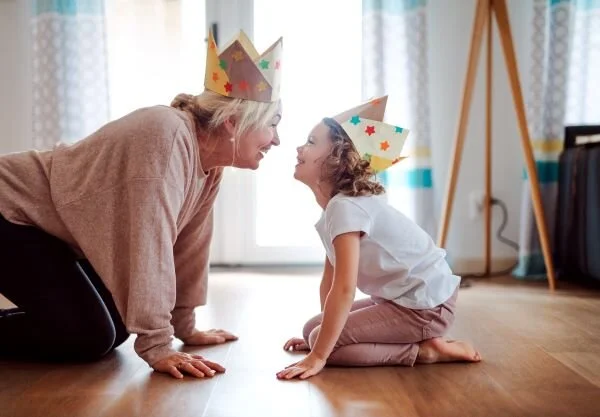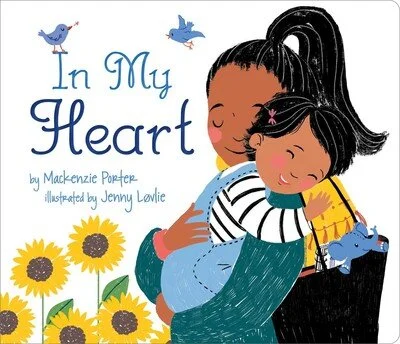Supporting Young Children Through Change
Helping young children adjust to a new caregiver, child care or school setting takes time under the best of circumstances. Helping a child who has experienced separation, loss or otherwise has a vulnerable nervous system, usually requires even more planning and attention from us.
Babies and young children who have these early experiences or vulnerabilities are often sensitive to the subtle changes in our moods, routines and rhythms. Helping them prepare for a more significant change (even a wonderful one!) can bring on stress and anxiety for us as the caregivers. Professionals in our lives may offer well intended suggestions that fail to honor the sensitivity of our child and our own intuition about what is needed. I am here to encourage you! Young children who have early stressors and losses can adjust changes in caregivers and you can do this! As they grow and your relationships with one another evolve, it will likely get easier and more predictable. Our little ones can grow in their sense of security in us as we grow in our confidence and security in ourselves.
Here are some of the strategies that I have found most helpful.
8 strategies to help you help them:
Check your mask. Your oxygen mask, that is!
As I mentioned above, change is hard, especially these days. You are not alone in having to make decisions for yourself, your child and your family where there might not be a “right” answer. Juggling financial, educational and social needs for a family involves weighing risks, benefits and necessities. Being the maker of decisions involves extra labor and weight. And you may benefit from having someone or a number of “someones” to help you hold that weight. That may be a combination of your partner, family, trusted friend, leader in your faith community, counselor, coach and/or mentor. Our circles are strained and smaller these days. Consider who and what you are missing and reach out when needed. Your children will benefit from having parents who are regulated, confident and hopeful in helping them navigate change.
Give your children advanced notice of changes
It can be tempting to wait until right before a change to start talking about it with your kids, especially young children. This could mean fewer days of tears and clinging. Yet, that time and the conversations (and possible tears accompanying them) are needed for children to prepare themselves for something new. This preparation gives them time to marshal the internal resources to cope. It also helps protect your relationship - their trust in you. In a world of the unexpected, you are their secure base and safe haven.
Answer their questions
Preparation can make a big difference in how we all adjust to change. Talking through and even drawing through the changes can allow children to rehearse their new routine and how they will handle the changes. Make visits to the new home/school/center. Drive by. Talk about what your new routine will be like. With less vocal children, you might need to anticipate questions. Books can be a wonderful way to reassure them and answer their questions. See below for a few of my favorites.
Acknowledge and validate feelings
Some worry is really quite normal. In fact we all have a brain that is constantly scanning for threat. A little bit of worry in anticipation of separation is a sign their brain is doing its job: working to protect them from potential danger. From an evolutionary perspective little ones are inherently safer being close to their parents. This bit of information can be reassuring to you and your child.
Sometimes as parents we want to shield our children or ourselves from the emotions around change. Our decisions can bring up guilt or sadness about a phase of parenting that is ending before we are ready. This can make it more difficult for us to hold our children’s big feelings. Yet, it is important to acknowledge feelings. Theirs and yours. As Dan Siegel and Tina Payne Bryson say, “Name it to tame it.” Acknowledging and naming feelings helps children understand themselves and build new skills. You can also validate feelings without agreeing with them.
And going back to trust, this helps them trust you as someone who sees them and really gets them.
When you label your own feelings (in an age appropriate way and with the assurance that you are taking care of yourself) it helps them understand what they see and feel going on without taking on added weight or worry.
Stick to a routine - keep the things that aren’t changing the same
As you know, children thrive on routine and predictability. Predictability can help your child weather changes big and small. Keeping your morning and evening routines the same as you prepare for and adjust to change is very helpful. It might also be helpful to delay the start of other activities until there has been some time to adjust to the new caregiver or setting.
Offer comfort and transitional items
Times of stress and transition are not the time for ditching blankies or bubbies. If your child already has a comfort object, make sure it can be accessible to your child during the early days of their transition. If your child doesn’t have a comfort object you can offer something of yours or a photo of your family to be tucked into their backpack or pocket for the day.
Say good-bye
It can be so tempting to back out of a room when your child appears calm and engaged in an activity with someone else. Holding your relationship at the center of your decisions can help center you. Disappearing acts build insecurity, the opposite of what you are looking for in the long run. Create a brief and consistent good-bye ritual. If your little one has a primary caregiver, help your child build a connection with that person by engaging them in conversation and including them in your good-bye. When my daughter was feeling nervous at preschool or kindergarten, I found that helping her make a warm connection (eye contact, high five, smile) with a friend or friendly adult often helped send just the right signals of safety to her brain to turn down the “alarm center” and wake up the playful and ready for learning “social engagement system” within a few minutes.
Create rituals for reconnecting
Make sure to have time when you come back together to listen, play and connect. Lots of adults need a few minutes to decompress when returning home from a day of work or school. After greeting your child with delight, give yourself that time AND then make sure you also have time for play and connection before heading into the bedtime routine. This could be as you prepare dinner, have some outside playtime, play some connecting games, or build in some more time for touch and connection during their bath and bedtime.
Books and stories are some of my favorite ways to talk about difficult subjects, teach something new or prepare for change. Sometimes custom “books” using photos or simple clip art can help a child rehearse and process a new routine or arrangement, better than a more generic book. Back in the day I often made them with copy paper and a sharpie… They weren’t very pretty but they served to help children cope with stress and change. And they could refer back to them when needed. Fortunately, there is tremendous variety these days in children’s books and media around topics supporting social-emotional health. I am including a few that are new and old favorites of mine.
A few children’s books about separation & change:
The links included are to the publisher, author or another source of additional information. There are no affiliate links.
Owl Babies by Martin Waddell (2017) - A sweet story about a trio of owls and their mother that reinforces the message that mommy (or daddy or ________) always comes back! The text of this book can be changed to include daddy, grandma, big sister or anyone who may be in a caregiving role with a toddler or young child. This was a favorite for my little one and she loved modifying the adult owl character to be whomever she was missing at the time.
In My Heart by Mackenzie Porter (2020) - I found this sweet book at my local Target. I wish it had been published a few years ago when my daughter was spending more time away from me and preparing to start preschool. In it a mother and child are shown going through their day from waking in the morning to reunion at child care, bath time and bed at home. And in the middle the mother describes all the times throughout her day that she is reminded of her little one.
“Though we’re not together, we’re never truly apart because you’re always on my mind and you’re always in my heart.”
“Lunchtime brings a smile because it’s joy that I feel when I realize we are eating the very same meal.”
The Invisible String by Patrice Karst (2000, 2008) - This popular book offers imagery and metaphor that can be helpful with separations short and long, including losses. In it the mother also reassures her children that their connection can’t be broken by distance, anger, behavior or death. The author has subsequently written a workbook of activities to accompany The Invisible String as well as a book specific to pet loss, The Invisible Leash.
The Kissing Hand by Audrey Penn (1993) - The Kissing Hand has been helping children adjust to preschool and Kindergarten for nearly 28 years! I recall recommending it to many parents and teachers as a young therapist and eventually gifting it to my step-daughter for her 5th birthday as she prepared to enter Kindergarten. The story of Chester and his worries about leaving his mom to attend night school for the first time is one so many can relate to. And the practice of the kissing hand, offering a kiss to be an invisible reminder of a parent or caregiver, is one we can replicate and repeat for our children in playful ways today.
For children who have experienced early adversity including unexpected separations (even at birth) and losses, transitions can bring up strong emotions and fears. If your child is taking much longer to adjust, struggling with challenging behaviors at child care/school or even refusing to go, coaching and/or child counseling can help. Together we can identify and address the root of their worries, support you as their secure base and help them build confidence and skills for navigating change.
Click the link to learn more about my approach to Child Counseling
Jeri Lea Kroll is a psychotherapist and parent coach specializing in early childhood, parenting, trauma, attachment across the lifespan and adoption using a lens informed by attachment theory and the relational neurosciences. She is also an adopted person and adoptive parent. She provides relationship-focused therapy and coaching to individuals, parents and families virtually from her office in Michigan.
Jeri Lea offers a free 30 minute discovery session to those considering parent coaching, child counseling or family therapy. You can request a discovery session HERE.




